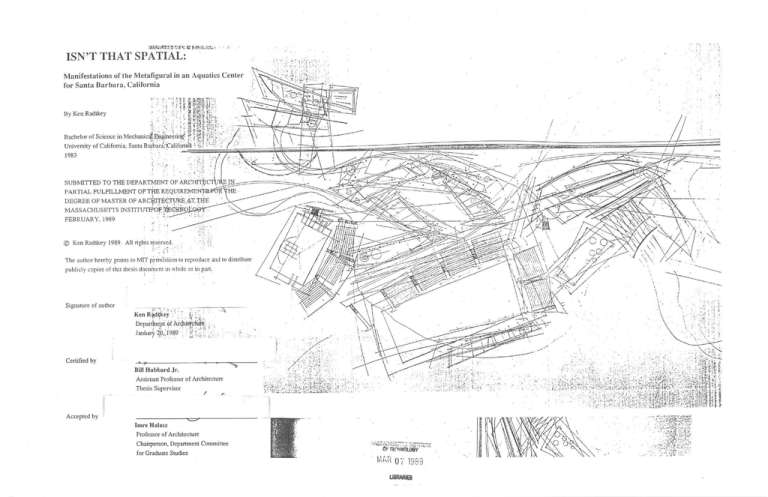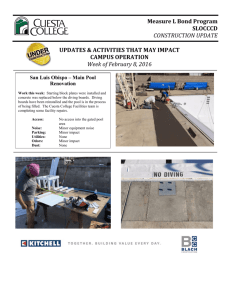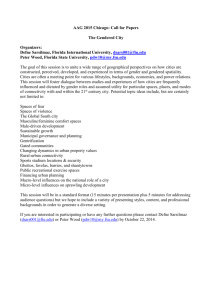
ISN'T THAT SPATIAL:
Manifestations of the Metafigural in an Aquatics Center
for Santa Barbara, California
By Ken Radtkey
Bachelor of Science in Mechanica
t
hredritg-
University of California, Santa Baxbar CaliforntA
1983
SUBMITTED TO THE DEPARTMENT OF AR.CHIT
PARTIAL FULFILLMENT OF THE REQUIREMENT
DEGREE OF MASTER OF ARCIF TURE
MASSACHUSETTS INSTITUT90 ffo IS
FEBRUARY, 1989
EI
HE
4T IE
@ Ken Radtkey 1989. All rights reserved.
The author hereby grants to MIT permission to reproduce and to distribute
publicly copies of this thesis dqcum1ent in whole or in part.
Signature of author
Ken R dtkey
Depart inept of
Januar 1 ,1989
ditN
Certified by
Bill Hubbard Jr.
Assistant Professor of Architecture
Thesis Supervisor
Accepted by
Imre Halasz
Professor of Architecture
Chairperson, Department Committee
for Graduate Studies
VF TECr19OLO8Y
M
AR 0'71989
UORARS
0,
ISN'T THAT SPATIAL:
iAt~
Manifestations of the Metafigural in an Aquatics Center
for Sant a Barbara, California
vowil
4b
By Ken Radtkey
4'
ABSTRACT
'I
This thesis is the design of a center for aquatic sport for
the City of Santa Barbara. The design supports a
variety of rituals to be acted out by users including
1
infant nonswimmers, elite international competitors,
and citizens of all ages seeking to recreate their bodies
0,
and spirits.
(
The term "metafigural", invented in my effort to
describe an attitude toward architecture and space
making. is introduced here. And, the images in tls
.0
N
thesis represent the last of several design iterations in
each of which I sought to further manifest the attributes
of "metafigurality".
Submitted to the Department of Architecture on January 20,
1989 in partial fulfillment of the requirements for the
degree of Master of Architecture.
Thesis Supervisor:
Title:
Bill Hubbard Jr.
Assistant Professor
of Architecture
2
se (in
h,
-U),
ood
one
aprcitin to Bilhe bb
aw
rces
should le awaRike )r the
theheard.
h
r
l
enest
-/egrpiclore):Sr
ent.
rd: a
of
\
through.n
.aringre
teachea
I00
-,anthes.
yo'rene see Drth
Love for
brigte half gta here for atest,
o
carigmetruh
Capeayu'eth
r
des!
Introduction
H. Allen Brooks, in his essay, "Wright and the
Gunther Behnisch has been exceptionally skillful
in his use of metafigural spaces and spatial
elements in his firm's design of the Catholic
University Library in Eichstatt. For reasons of
association and understanding, Behnisch does
not want to separate the entrance foyer and the
reading area of this building into two distinct
spaces. Behnisch knows, however, that the
entrance foyer is a place of movement and noisy
activity, while the reading room, is a place of
calm and repose. His design allows these
seemingly incompatible places to be adjacent
and visually connected but acoustically
separated. At the root of this design was the
creation of the figural spaces and elements which
comprise the entrance foyer, the reading area,
and the partition between them. Behnisch shows
here the social utility in creating metafigural
Destruction of the Box" describes the way that
Wright designed interior space, and at one point
summarizes:
"Wright analyzed the components of a
room, which basically was a box. He
realized that the corners were the most
expressive element, so he demolished
them first. He then dismembered
intermediary walls, ceilings, and even
floors. Finally, as was later to occur
in synthetic Cubism, he reassembled
/
the shattered pieces (images) in a
different spatial context."
Brooks tells us that the "destruction of the box"
/
/
/4
is the first essential design step for Wright and
for others who would design toward a space
where all elements are figures in a continuous
context of sibling figures (as opposed to a space
*-architectural
Just as Wright reassembled shattered images of
IL-
space.
N
N
/
I
N.
N.
/
/
N
elements is an embodiment of what I will call
metaigural spatiality.
\
spatiality while creating a dynamic and exciting
\
where all elements are figural disconinuities in a
"ground"). A space comprised entirely of figural
The work of Behnisch has proven that a heavy
reliance on the orthogonal as an ordering tool,
\
rT
-
especially for public and semi-public spaces,
may be given up. This seems reasonable
considering our natural abilities to understand a
very complex place (like the library foyer in
Eichstatt) when we are actually in it. The
arrangement of discrete entities in a complex
("free") manner has precedent in the near past in
Scharoun's Theater at Wolfsburg or his
Philharmonic in Berlin. And, at the beginning of
Western history, the Greek temple precincts give
us striking examples of site planning based on
the orchestrated serial experience and discovery
of "freely" designed sites.
----
a
Architecturally, such spaces become charged
with a dynamic potential that implies for us
freedom of movement. Such spaces tell us of
their designer's conscious tuning of space to sets
of imagined uses. Such spaces remind us of the
rich complexities of the natural world that we
know so intimately. Such spaces are an
appropriate response to particular formal and
programmatic needs in architecture.
/
\
/
-
the box (elements of discrete identity) in a
particular spatial context, others, like Scharoun,
Scarpa, and Behnisch, can be seen as creating
their own reassemblages of the box within new
/
/ /
//
-
"'7.
spatial contexts. If Wright's spatial context was
a built garden landscape, the lush, exciting
**
spaces of Behnisch's Hysolar Building can be
seen as having been formed within the context of
. *
a "built jungle". Critical to this metafigural
reassembly is the definite integrity of the various
elements that have been tom from the whole, and
their distribution through space as systems of
elements with legitimate identity.
4
200
(
I.-'
/4
7kAn undeveloped site in the City of Santa Barbara
is the setting for an aquatic sport center. The
center will include the competition pools, diving
tower, weight rooms, locker facilities, spectator
areas, offices, classrooms, mechanical equipment
spaces, cafe, parking etc. Every day, for most of
the year, this complex will be used for a great
variety of recreational and educational programs.
In addition, and quite importantly, one or two
weeks each year, the City of Santa Barbara
would like to host international level swimming
and diving competitions at this facility.
pp-
00-
The design of the new aquatics complex for the
City of Santa Barbara can be successful only
when two major issues are confronted.
First, although this facility must be of necessity
large , the place must avoid overwhelming the
varied community that will use it. By
connecting people to the rich complex of
-
activities and rituals that will occur there, the
place becomes an environment to discover as
opposed to a place of intimidation.. An example
of how to clearly connect a set of spaces using a
spatially metafigural assemblage of architectural
elements, is seen in The library at Eichstatt.
Creating a communicative. metafigural spatiality
using all the elements within the built landscape
(pools, spectator seating, structure, closure, etc. )
can, therefore, meet the disparate needs of many
users.
Secondly, the permanent alteration of a fantastic
natural landscape by a large center like this must
not be an intervention of dominance or
submission. A set of elements, introduced and
native, reacting in sympathetic parity is needed.
A metafigural design would lead us to a place of
elemental siblings in a sensuous landscape of
both built and naturally occurring identities.
41
The design of a metafigural spatiality across the
site is the primary means through which the
programatic and social (spatial!) needs of the
community are addressed in this project.
~i
I,
K .ki
/11
Facing directly south, the site overlooks the
Pacific Ocean at a distance of two thousand
feet. The sandy coast runs east-west in
SantaBarbara. From here, just off the
shoulder of the dry hill, the sun rises and
sets over water for most of the year.
300.
.4
I
350O
A twelvehundred foot blade of reinforced
concrete is formed in thI at
sigsur
wall technology. Runngtw
tyih
degrees north of east-etthbldapar
and disappears at a datu
f30fe
/11
The earth above 360 feet elevation is
removed. The form of the land is revealed
in the section cut by The Wall, and in The
Plane exposed by the removal. The wall is
battered back at an angle of fifteen degrees.
The solstice sunset casts long shadows down
the length of the wall which is visible from
the sea as a light sliver in the hillside. A
place is made for the center for aquatic
sport.
/
- -...
.2
d
-
).
;
,
i~4.3
i
1~
4~h
K4~
,:<
A
.1 :.....-.-.-.--.---.-.
...
. ..
......
...
.
.
.
.......
10
N,
I
4
-------
/7
,~,~-
/'
1'
h
j>+cizz
/
II
rJ ~L--.
/
-
'r
-:~
'I
4'
I,
~'
/
/7','
/
/
'I
Entering the site by car, one is channeled
between the wall and a 3 foot by 350 foot
reflecting wing of water that curves slightly
away from the wall as the main pedestrian
entrance nears. The main pools include: the
trapezoidal instructional and childrens pool,
a 60 meter by 25 meter competition pool
configurable with bulkheads, a diving tank
with springboards and platforms up to 10
meters, and a reflecting pool near the end of
the plane.
11
The shadows cast by slabs and platforms
reveal places in the air. "Free" forms are
determined by a complex process of trial
and error imposed upon design intention and
imagined use.
Ol/
12
The shadows cast by columns show all roof,
floor, deck and platform vertical loads to be
born by columns. Often, however a column
line will continue out from under the
element it was supporting to simply define
-
~~~~~~~direction
n
h
om
ftelgt
13
The shadows cast by the roofs reveal some
elements above the classrooms and at the
judges building that are both roof and deck.
The roofs are all formed from concrete
poured into corrugated steel pans. in
section. all but the deck roofs are concave to
the sky, oftethrarlagarsofof
covering uncniindsae
14
The shadows cast by the glass occurring at
the center for aquatic sport show glass to be
used to theirally or sonically isolate while
maintaining a strong connection to the light
and to the movement of people in the out of
doors.
NA
f/-1
15
From above the parking lot, we see the roof
over the loading dock helping to establish
the main entrance to the center. Cars must
pass near the entrance before parking at the
closest available space. Initial movement on
foot is guided by the wall whose primally
rough, earth formed surface is bright in a
day long confrontation with the sun. The
roof of the cafe, at the far end of the wall is
visible immedidately as a silhouette from the
74.~
,Z
-
I-
*
~-
-,--
-6
A,
-
t
car and foot entrances.
P19-1
*
-
~.
..
S
~'*.'.-
-j.~
~
5~4
I
-~
*
141
* .c,.-.
9
I
i
r
--
-- -
/-
/7
44/7 /
-
--
/
/
#5-
-
/
\
~
~
-
-
-
-
-
.i.; W&I.
16 r
IMMJOF-T.lglpw*A
LIS
le..k
;.~j >WK~
i.,,
*
~
,
q
.i;4
IN
-- I
2'
I/
-VIA
'4
-.
-6
17
I,-
The instructional-recreational pool has
deployable floating islands that can be
removed to allow lap swimming and warmup for large competitions. Facing the pool is
a terrace of grass for sunbathing providing a
good view of pool for parents. Underneath
the trays of grass is a storage and
mechanical area lit naturally by skylights
and by the glass filled gaps between trays.
Adjacent to this area is the main loading
dock and delivery entrance for the Center.
I
I
V4
-i.
~A.
-
J
w
i
4.
-
-,
-
-~
.
---
V
-~
~
V
-
K'
A.
.7
AJ
The locker and changing buildings for men
nand
women face each other across a light
filled garden enclosed by glassblock walls.
Both have freestanding concrete walls to
their backs. The curved back wall of the
women's lockers works with The Wall to
define the initial entrance to the center.
ezzanine levels are suspended from beams
Acting as great screens for the spaces behind
them, seating wings for two thousandy
spectators look onto the main competition
pool. The pool, which is oversized to 75
-1
feet by 180 feet, can be configured withbulkheads to a variety of competition
O
lengths, or to run two intemnational
waterpolo matches simultaneously. Made of--metal, all the competiton pools float in the-'r
carth, and must be self supporting due to
severe earthquake hazard in the ara.Th
r-
pool decks are precisely flush with waterlevels to facilitate a rim-flow gutter and
wave damping system. The decks,
constructed of a iHtN composite material are
cantilevered from the sides of the tanks, and
overflow, filtration, and conditioning piping
-k
-
runs through the spaces undemneath. A long
roofdeck observation platforn on the
outside of the pool deck covers coaches',
-10
officials' and team/press rooms.--
-
-
:-kit
I
,
qz
FIN-
(
FI
H
IL
N;
* F,-.
in
I
AtC
.6
e competition diving tank, springboards
-mrilat forms are set 18 feet down and off
of The Plane in a steep hollow. While the
tank is floating in the earth, stands and
platforms are born on columns and interfere
with the form of the land as little as possible.
From The Plane divers can be seen across
space leaping into the air, and disappearing
from view. Divers ascend to a platform
upon which the three meter springboards
rest. Platform divers can climb stairs further
to 5,7, and 10 meter platforms.
P1'
.~1'
*
4'
U
K
..3*
..
.
..- t ~ C.
-'
*..
a
-F
:4
.
..
.--
*
-j
$510.
.1
*~~L
/3~
- t
-
u%--
Directly adjacent to the spectator seating,
and overlooking the diving tank is a building
housing exercise, training, and weightlifting
facilities. The three classroom spaces can be
seen forming a metafigural courtyard of
sorts facing the main competition pool and
the entrance.
.
i
I
-
'
k*
I
4Z,.
Ut
. - -. - Y
~.a
-
.
-
-
.
-
-is
.1.'.-.
LCL
.-
d
-
The end of the site, which is visible from the
first entrance to the site, is marked by a
ramp flying up over a reflecting pool and
The Wall to reach a cafe and meeting place
on a promontory. The view is unobstructed
over a 270 degree arc. Displaced from The
Plane, the cafe and its sundecks are
supported on columns in order to make the
least impact on the land.
(
.1
**~
*1
9
.~
,.
-. 4
BIBLIOGRAPHY
Behnisch & PartnersDesigns 1952-1987,
Stuttgart: Rigby - Fachubers, 1987.
Borges, Jorge Luis. "The Other Death.
From Eye of the Heart, Short Stories from
Latin America. Ed. by Barbara Howes.
New york: Avon Books, 1973.
- .
c
-
--
--
-
Cage, Jo hn. Empty Words - Writings '73'78
by John Cage. Middleton, Connecticut:
Wesleya n Universtiy Press, 1979.
-~
rDoxiadis
-
-
,
s, C. A. ArchitecturalSpace in
-
Ancient Greece. Cambridge, Massuchesetts:
-
Pre:ss, 1979.
-NMT
ow
-
;t
-
-
-
-;
-
Works by Leonardo
Da Vinc i. New York : Dover Publications,
1980.
Leonard IoDrawings 60
-
-
*4-
~
-
-
-ie*
*
'y
-
-
r
Marquez z, Gabriel Garcia. One hundred
Years of Solitude. New York: Avon Books.
4
It.
-
-
*
-
-
-
-
-
-
c
New Yo rk : Anchor Books.
-- -
-
-
op
sf
--.
-
j~
rro
P aul. Zen Flesh Zen Bones A
Collection of Zen and Pre-Zen Writings.
*0
4-1-
1970.
-Reps,
--.
If'.
'
-'4Tschum
i, Bernard. Cinegramme Folie Le
ParcDe La Villette. Princeton, N. J.:
Princeto n Architectural Press, 1980.







